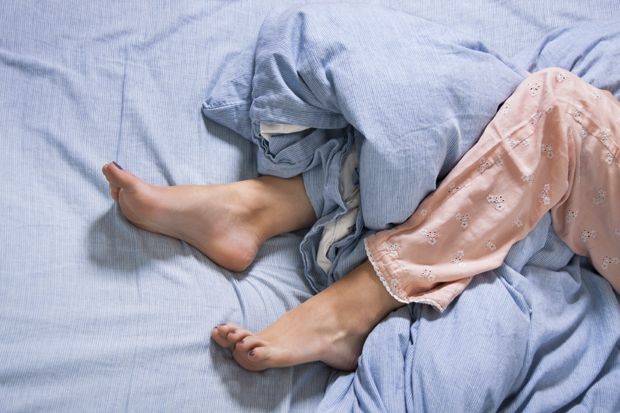
Submitted by Drs. Bohn, Nielsen, Castillo, Benson, and Wright, The Vein Specialists, LLC
Millions of Americans struggle with restless leg syndrome — if you’re one of them, here’s what you can do about it.
Restless Leg Syndrome (RLS) — also called Willis Ekbom Disease — was first described by Chinese physicians in 1529, and in 1763 by French physicians. The condition was first suggested to be associated with venous insufficiency by Dr. Karl A. Ekbom in 1944. RLS is characterized by unpleasant or painful sensations in the legs and an urge to move the legs. Symptoms occur when the patient is relaxing, inactive or at rest, and can increase in severity during the night or latter part of the patient’s wake period. Moving the legs reduces and may relieve the discomfort. The discomfort and constant need to move the legs disturbs sleep and can lead to impairment of function in daily life.
Epidemiology
This common disorder affects as much as 10 percent of the U.S. population, with approximately two percent to three percent of adults and one million children in the U.S. experiencing moderate and severe symptoms. Additionally, studies show that RLS is twice as prevalent among women than it is among men. 80 percent of those affected by RLS also experience Periodic Limb Movement Disorder during sleep, in which the patient has brief “jerks” of the legs or arms while sleeping. If you’ve ever had throbbing sensations in your legs or limbs when you’re relaxing or attempting to sleep, you may be experiencing the symptoms of Restless Leg Syndrome (RLS).
What causes Restless Leg Syndrome?
Experts believe that RLS is a dysfunction in the brain’s basal ganglia circuits. Patients with Parkinson’s disease (which is also a disorder of the basal ganglia) often experience symptoms of RLS as well. There also appears to be a correlation between RLS and other chronic diseases such as kidney failure, diabetes, and peripheral neuropathy. Treatment of these underlying diseases often provides relief from RLS symptoms. In some cases, venous insufficiency can cause RLS.
RLS can also be caused by pharmaceuticals, such as…
- Antinausea drugs
- Antipsychotic drugs
- Antidepressants that increase serotonin
- Cold and allergy medications (containing sedating antihistamines)
While the cause of RLS is currently unconfirmed, there’s a lot we do know about how it functions. The disorder is often found in multiple generations of families, with symptoms usually occurring before the age of 40, indicating that it may be passed down genetically. Additionally, women can sometimes experience RLS during the final trimester of pregnancy, though symptoms generally disappear within a few weeks after giving birth.
What are the Symptoms of RLS?
RLS symptoms include aching, throbbing, creeping, and unpleasant pulling sensations. The intensity and severity can be anything from slightly uncomfortable to debilitatingly painful. Often, moving the legs (or other affected body part) can relieve or minimize the discomfort.
Because the symptoms of RLS often strike when patients are trying to relax or sleep, the discomfort and subsequent constant motion of the limbs can lead to sleep deprivation, exhaustion, fatigue, loss of work, and depression.
The association of RLS with venous insufficiency
Those who treat varicose veins have long heard their patients’ descriptions of throbbing, buzzing, creepy-crawly pains in the lower extremities — symptoms that sound very similar to those of Restless Legs Syndrome. RLS is a common disorder with a known association with venous insufficiency. RLS is commonly treated with dopaminergic drugs, but these drugs have numerous short and long-term side effects. When RLS co-exists with venous insufficiency, treating the venous insufficiency can provide substantial improvement in the patient’s symptoms and subsequently the patient’s quality of life.
What are the options for treatment?
Changes in lifestyle and consumption habits can reduce the symptoms of RLS in mild to moderate cases. Decreased use of tobacco, caffeine, and alcohol are often encouraged.
Other suggestions for treatment include…
- Maintaining a regular sleep pattern
- Daily exercise and leg massage
- Supplements such as iron, folate, or magnesium
- Applying a heating pad or ice pack
- Taking a hot bath
While there is no magic cure for Restless Leg Syndrome, there are treatment options that can help you alleviate symptoms and manage the associated pain. There is no reason to suffer through sleepless nights and exhausted days due to RLS.
To see if you may have insufficiency that may be causing your RLS, call The Vein Specialists today at 309-862-4000 to schedule a consultation with one of their physicians or request an appointment online at www.ILveins.com. They have convenient locations at 3302 Gerig Drive in Bloomington or 2011 Rock Street, Suite D2 in Peru.

